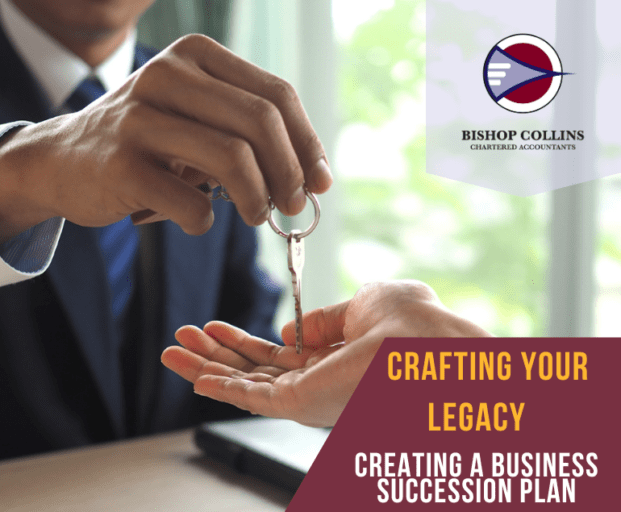“Good fortune is what happens when opportunity meets planning” – Thomas Edison
Thomas Edison hit the nail on the head when he linked good fortune with planning. In the context of succession planning, it means more than just keeping the business going. It’s about setting up future leaders for success and making sure your business remains strong for years to come.
Understanding Succession Planning
Effective succession planning means dealing with tax issues that can come up when a business changes hands. It’s about making sure the handover is smooth and doesn’t cause big tax problems.
The goal is to figure out what taxes will be due soon and find ways to lessen them. This helps increase the financial benefits for both the current owner and the next.
Establishing the correct strategy that meets your goals is essential for effectively navigating issues related to taxes. This necessitates grasping the effects of Capital Gains Tax (CGT) when transferring business assets and understanding potential liabilities tied to other indirect taxes such as GST, Stamp Duty and Land Tax.
Given that this process can be complex and may take substantial time, consulting with a professional tax advisor is recommended. Doing so will help secure appropriate management of taxation matters and protect against possible fines or penalties.
Step 1: Define Your Succession Objectives
Initiating the succession planning process begins with establishing your goals, which can vary widely depending on personal circumstances, business goals, and unforeseen events.
- Are you looking to retire comfortably on the proceeds of your business? This is a common reason for many business owners to initiate a succession plan. Ensuring a comfortable retirement requires a strategy for extracting value from the business in a tax-efficient manner.
- Perhaps you’re considering transferring ownership to family, selling it to staff members, or finding an external purchaser. In cases involving family members, the plan may include training and mentoring to prepare them for future leadership roles. Selling to staff members might involve setting up employee stock ownership plans (ESOPs), while selling to an external party may necessitate a different approach to valuation and negotiation.
- Are you seeking to exit the business due to health concerns or a desire for a lifestyle change? If a business owner faces health issues, they may need to expedite the transition to ensure the business continues to operate smoothly.
- The sudden loss of a key executive or owner can thrust a company into crisis. Succession planning in anticipation of such events can help ensure the business remains stable and the transition of responsibilities is seamless.
- Legal and financial changes, such as divorce or partnership dissolutions, can also necessitate a succession plan to determine how the business will be divided or managed moving forward.
Each of these scenarios requires a tailored approach to planning that aligns with the specific objectives and circumstances of the business owner. This will also influence which tax strategies are most suitable for achieving these aims.
Example 1: Disposing Of Your Business
When you are looking to divest from your business, it’s essential to consider several critical elements.
At the top of the list is getting a grasp on the tax repercussions that come with such a move.
How you orchestrate the transaction could make you subject to taxes like Capital Gains Tax (CGT).
Timing plays an imperative role when shedding ownership of your business, especially if retirement is on the horizon. It’s crucial to ensure that proceeds from selling off your enterprise will support your transition to retirement.
When considering the value you wish to receive for the sale of any business or major asset you must only think of the market value for that asset. Be careful not to fall into the trap of saying “I need this much to fund my retirement”. A buyer is not there to support your retirement. Adopting this perspective will help you become more realistic and plan more effectively.
In addition you will be required to know what financial support you’ll need once you retire as well as setting clear goals for post-retirement life—making sure there’s harmony between those objectives and how/when you choose to hand over control of your business operations.
Example 2: Closing Your Business
Closing your business involves many important details. It’s similar to selling your business, and you’ll need to consider taxes like Capital Gains Tax (CGT) and GST. Before you close up shop, you’ll have to take care of final tasks like paying any remaining business taxes and cancelling your GST registration.
Apart from dealing with taxes, you’ll also have to think about your responsibilities to your employees, the people you owe money to, and others involved with your business. Before you close your company, pay off any business debts, take care of your employees’ benefits, and handle the remaining business assets properly. A well-planned exit strategy will help you close your business smoothly and avoid legal problems.
If the business is operated through a company structure and you have excess cash after realising all assets and liabilities, you may not want to take the money out in one period but over several periods to effectively manage your tax.
Example 3: Transitioning to Family: A Delicate Dance
Passing your business to family members is a sensitive task that involves more than just signing over the title. It’s a complicated dance of managing family dynamics and ensuring fairness in the distribution of roles and benefits.
This process also comes with legal and tax challenges. For example, giving your business or assets to family could lead to significant tax costs, like CGT.
Example 4: Understanding Buy-Sell Agreements
Succession planning keeps your business going strong, even when owners change. Buy-sell agreements are key. They’re contracts that set rules for what happens if an owner dies, gets sick, leaves, or has to be kicked out.
These agreements keep the business stable by making sure only the right people can take over. They set a price for the owner’s share ahead of time, so there’s no arguing later.
Buy-sell agreements help the business keep running smoothly by letting the right people buy into the company little by little. They prevent fights by having clear rules for who can make big decisions for the business.
Step 2: Business Valuation
Understanding your business’s value is key to planning for its future. It’s important to know what your business is worth today and how to make it more valuable when you’re ready to pass it on. Different ways of calculating your business’s worth can give you different insights, so it’s smart to get professional help to ensure you’re getting a true picture of what your business is worth.
Determining Your Business’s Worth
Knowing what your business is worth is a big part of planning for its future. Getting a professional to value your business helps you avoid guessing its worth incorrectly, which is important for making a smart succession plan. This valuation shows you the real market price of your business and points out areas that might need improvement.
A variety of techniques are available to appraise the market value of a business, each with its unique approach:
- The Times Revenue Method – This method calculates the value based on the company’s revenue streams. It multiplies the current revenue figures by an industry-specific multiplier to estimate the company’s worth.
- Future Maintainable Earnings Multiplier – Instead of revenue, this method looks at the company’s earnings, applying a multiplier to the profits. The multiplier reflects the industry’s current economic climate and the business’s growth potential.
- Discounted Cash Flow (DCF) – A more complex valuation method, DCF forecasts the business’s future cash flows and discounts them back to their present value. This approach considers the time value of money, offering a present-day valuation based on future earnings potential.
- Net Tangible Asset Value – This technique is based on the company’s balance sheet. It calculates the value by looking at the company’s total assets minus its total liabilities, representing the net equity of the business.
- Liquidation Value – This method determines the value by estimating the amount of money that would be left if all assets were sold and liabilities paid off. It’s a worst-case scenario valuation that assumes the business is being liquidated.
Enhancing the valuation of your business not only strengthens its succession plan, but also improves retirement prospects for proprietors who intend to sell their stakes in the company.
Step 3: Simplifying Tax
When you’re planning who will take over your business, it’s important to understand taxes. Start planning early to avoid big tax bills and keep more money in your pocket.
Each step of handing over your business, like selling it or giving it to someone else, has different tax rules. It’s a good idea to talk to a tax expert to make sure you’re making smart choices that save you money on taxes.
- Capital Gains Tax (CGT) Considerations: Understanding Capital Gains Tax (CGT) is a big piece of the succession planning puzzle. When you sell business property or pass it on, you might make a profit or a loss. This can lead to a tax bill, so it’s good to know about special breaks for small businesses that could lower or even wipe out that tax.
- Small Business CGT Concessions: These can be a huge help, but you have to meet certain rules to get them. It’s really smart to talk to a tax expert to make sure you get all the tax savings you can when you’re planning for the future sale of your business.
- Stamp Duty: Changing who owns your business can bring up different tax costs, like stamp duty if you’re passing it to a family member. It’s really important to get advice from a tax expert as they can help you figure out all the taxes you might have to pay and show you ways to pay less. For example an intergenerational transfer of rural land can be exempt from Transfer / Stamp Duty in some states
- Planning for Retirement with a Self-Managed Super Fund (SMSF): When you’re ready to stop working, you need to make sure you have enough money to enjoy your retirement. One way to prepare is by using a self-managed super fund (SMSF). An SMSF lets you be in charge of your retirement savings and can help cut down on taxes. However, managing an SMSF comes with a bunch of rules. It’s a good idea to talk to a financial advisor to make sure you’re on the right track and not breaking any laws.
- Making Ownership Transfer Simpler: Changing who owns your business can be tricky. There are different ways to do it, and each one has its own tax and legal rules. Sometimes, special trusts can help make the transfer smoother. It’s important to use the correct legal documents to avoid extra taxes or fees. A will can pass on your business after you pass away, but it’s not enough by itself, especially for businesses held in trusts.
Step 4: Develop a Comprehensive Succession Plan
Having succession plans for who will take over your business is crucial. This plan outlines who will step into key roles, sets a timeline for the transition and explains how it will affect the business’s finances. To be sure that you and the next owners get the most financial benefit, the plan should also include ways to handle taxes smartly.
Your plan should be flexible, changing as needed when there are new developments in your business, changes in your family, or new tax laws. Using a template for your succession plans can make updating it simpler. With a well-prepared plan, you can feel confident that your business will keep running smoothly with the new leaders in charge.
Step 5: Implement Estate Planning Strategies
The process of succession planning makes sure your business keeps going after you’re gone, and estate planning decides who gets your personal and business stuff when you pass away. Combining the two helps pass on your assets easily and can save on taxes.
Estate planning includes making a will, setting up trusts, and planning for taxes you might owe. For business owners, this could mean giving the business to someone else or selling it for the best price.
Step 6: Seek Professional Advice
When you’re changing who’s in charge of your business or getting it ready for new owners, there are a lot of rules and tax issues to think about.
That’s why it’s so important to get help from experts like business advisors, accountants, and lawyers. They know the rules and can help you make a plan that works.
With their help, you can figure out what your business is really worth and find the best ways to handle taxes. This makes sure you don’t run into any legal or money problems later on.
Your Partner In Transitioning Your Business
Bishop Collins helps you plan who will take over your business. We make it easier by:
- Explaining the tricky parts of planning for the future
- Giving clear advice to move forward with confidence
- Making tax stuff less complicated
- Ensuring a hassle-free change in your business leadership
We’re experts at picking the right people for important jobs, like who will lead your team. And we’re here to support you every step of the way.
Remember, you’re not alone when it comes to business. Get in touch with us today to kickstart your succession planning the right way.







